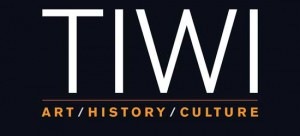
The Tiwi Islands are 100km north of
Darwin where the Arafura Sea joins the Timor Sea. They comprise Melville Island and Bathurst Island, with a combined area of 8,320 square kilometres.
The Tiwi people have always been remarkable producers of art and were pioneers of the Aboriginal art movement. This book gives an in-depth look at the people and their art. Tiwi culture, history and traditional stories are vividly expressed through lines, patterns and colours, in carvings, and in their modern paintings, prints on paper and fabric and pottery.
Tiwi : Art/History/Culture contains descriptions of ceremonial arts, rare historical photographs and biographies of the artists, as well as actual historical events that are interwoven with more than 800 images obtained over five years of research in public and private collections of art and imagery. Tiwi stands as a monument to Tiwi people and their current endeavours to keep Tiwi culture strong.
Jennifer Isaacs has been a pioneer in moves to gain respect for Aboriginal culture for over 40 years. In 2003, she was made a Member of the Order of Australia in recognition of her work promoting Aboriginal culture and assisting Aboriginal artists. She is the author of seminal books on Aboriginal art, religion, plant use, food, medicine and oral history, including the ground-breaking Australian Dreaming, published in 1980. She has maintained a close association with Tiwi families and elders for more than 40 years.
Jennifer says the book about the Tiwi Islands came through an opportunity to choose a cultural area that could be looked at in depth and be presented to Australia as one of the nations within Australia, so that people could have a deeper understanding of Aboriginal art and culture.
“It is not just because they are special and separate, but over the last 15 years Australia has been won over by Aboriginal art. The Tiwi were right there at the beginning, and they were the first and best and most innovative and they got set aside by the pacemakers, maybe because they thought it was a bit old-fashioned and ethnographic – ochre, bark and natural materials – but within that milieu it was incredibly beautiful and interesting,” Jennifer says.
“They were the first to adopt new materials like pottery and glass and paper. They were the first to come south and perform in major theatres – starting in Melbourne in 1963. They had their own dance groups. Australian Tourism adopted the look of a Tiwi person in full body paint to signify Aboriginal Australia and they have just kept going all this time. So this was my chance to give them a bit of applause. I thought that this book will help the Tiwi from this point on until a Tiwi researcher wants to do it their way.”
Jennifer says Tiwi art is so remarkable because it is completely different.
“It is not going too far to say the Tiwi are a separate Indigenous people. Tiwi Elders say ‘We are Tiwi – we are not mainlanders’. They don’t want to pretend to be better than or more this or that than Aboriginal mainlanders but they are definitely a different culture,” she says.
The Tiwi Islands also have an interesting history, which is detailed in the book.
“The Tiwi have a long history of associating with various invaders or the ships that foundered. Then there was a violent period of buffalo hunters and mainland people from Croker Island who became like Mafiosi for the Buffalo hunters. Then a mission came along in 1911,” she says.
Jennifer toured with three Tiwi artists
to promote the book in December to Melbourne, Canberra and Sydney.
They visited the National Museum of Australia in Canberra on 13 December,
and the Museum handed back some
Tiwi items that have been taken home to
a new museum on Melville Island.
Tiwi: Art/History/Culture has been published by Miegunyah Press, part of Melbourne University Publishing. It costs $119.99. It is a major contribution to understanding the Tiwi as a unique regional Australian cultural group, the Indigenous nation of the Tiwi Islands.
“It is an expensive book, but people should go to their libraries or educational institutions and ask for it. You can’t produce a book with 800 colour photographs online,” she says.
For more information on the book, visit www.mup.com.au
Comments are closed.